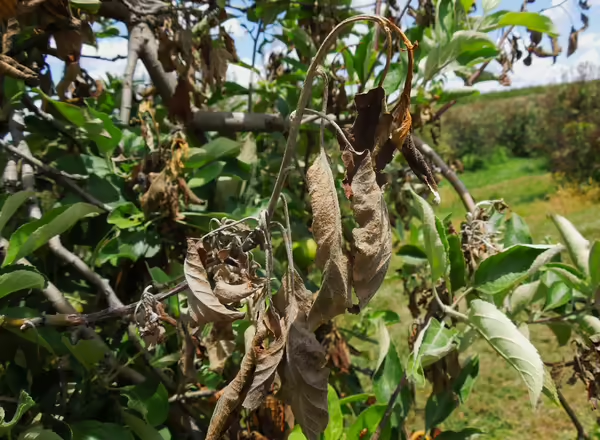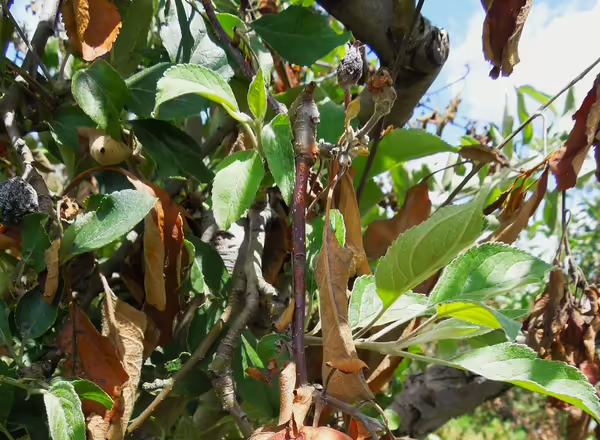
Apples and pears are popular trees to grow for people interested in growing their own fruit. However, they aren't without any problems. A variety of insect pests and diseases can plague them. One common and potentially serious disease is fire blight.
What is fire blight?
Fire blight is a bacterial disease caused by Erwinia amylovora. While it is most commonly noticed when infecting apples and pears, it will also infect over 75 species in the rose family (Rosaceae). Other plants that can be affected include Callery pear ('Bradford', 'Aristocrat', 'Redspire', etc.), cotoneaster, crabapple, flowering plum, hawthorn, mountain ash, quince, raspberry, serviceberry, and spirea.
Infected plants may develop various symptoms, including blossom blight, fruit blight, shoot blight, and cankers.
Blossom blight
Flowers infected with fire blight will become water-soaked, wilt, and turn brown. The bacteria will spread into other flowers and shoots.

Shoot and fruit blight
Infected shoots and twigs will turn chocolate brown to black in color and appear as if they have been scorched by fire. The twig or branch's tip will often curl back, forming a distinctive shepherd's crook. The infected leaves will remain attached to the dead branches throughout the summer.
When fruit are infected with fire blight, they will turn brown to black and may become covered in droplets of whitish-tan bacterial ooze. Eventually, they will shrivel up and become dry and remain on the tree.

Cankers
The fireblight bacteria may continue to move through shoots and into the main branches of a tree. As this happens, cankers will form that are sunken and dark brown to purple. As cankers grow larger, they can girdle branches causing dieback.
While fire blight usually does not kill apple and pear trees, it will cause them to become unsightly and reduce the amount of fruit the trees produce.
How does fire blight infect plants?
The bacteria will overwinter along the margins of cankers in infected plants. When conditions in the spring become warm (around 65°F) and wet, the bacteria will begin to multiply and ooze out of the cankers. Insects are attracted to this ooze and will spread it. The bacteria can also be spread by splashing rain and wind.
The most common way the bacteria enter plants is via the flowers. Insects, such as flies and bees, that feed on the bacterial ooze may transport the bacteria to flowers as they visit and pollinate them. Infection can also occur via wounds on the plant. The wounds can be caused by insects feeding on the plants (they can also spread the bacteria) as well as damage from pruning, wind, and hail.
Young, succulent shoots are susceptible to infection. Therefore, plants that have been heavily pruned or fertilized with nitrogen (which promotes new growth) are more susceptible to fire blight infection.
How can I manage fire blight?
Plant resistant cultivars
The best way to manage fire blight is to plant resistant cultivars. Apple cultivars such as Gold Rush, Empire, Enterprise, Liberty, and Winecrisp have some resistance to fire blight. Pear varieties that have some resistance include Magness, Maxine, Moonglow, and Summercrisp. While they are not completely immune to fire blight, resistant varieties are less impacted by the disease than other varieties.
Prune out infected plant material
Infected stems and branches should be pruned out of the tree. This is best done while the plants are dormant to avoid spreading the bacteria to healthy parts of the plant (or other plants). Infected branches should be pruned at least 6 to 8 inches below cankers and infected areas.
If you feel you need to prune during the growing season, make sure to do it when conditions are dry to reduce the chance of spread. Prune 6 to 12 inches below visible symptoms, and make sure to sanitize pruners between each cut.
If you have a Callery pear that is infected with fire blight, make a pruning cut at ground level and replace it with a more desirable species.
Regardless of when you prune your trees, make sure to destroy (burn, bury, etc.) or remove the infected plant material from your landscape.
Avoid overfertilizing trees and excessively pruning apple and pear trees during the growing season. These can lead to flushes of new growth, which is highly susceptible to fire blight.
Pesticides
Because the pathogen that causes fire blight is a bacteria, fungicides won't work to control it. However, there are some pesticides that can also be used to help manage fire blight. As with all pesticides, make sure to follow all label directions.
Copper compounds can be sprayed during the dormant season and at green tip. This can help reduce the amount of bacteria that builds up on the surface of the trees.
Streptomycin (an antibiotic) can be used during bloom to protect flowers. Streptomycin will kill the fire blight bacteria, preventing it from infecting the flowers. If Stryptomyacin is not used properly, there is a risk that the fire blight bacteria can develop resistance to it.
If you use an antibiotic spray, take steps to reduce the chances of resistance developing:
- Only use the rate recommended on the label
- Do not apply more than three or four times in a season (when plants are blooming)
- Do not use after fire blight symptoms have developed. They can't cure the disease, only prevent it
Good Growing Tip of the Week: Under ideal conditions, the bacteria that causes fire blight can rapidly increase. According to the University of Kentucky, at 70°F, the bacteria can double every 20 minutes, meaning one cell can become one billion cells overnight.
Signup for our emails! Want to get notified when new Good Growing posts are available? SIGN ME UP
MEET THE AUTHOR
Ken Johnson is a Horticulture Educator with University of Illinois Extension, serving Calhoun, Cass, Greene, Morgan, and Scott counties since 2013. Ken provides horticulture programming with an emphasis on fruit and vegetable production, pest management, and beneficial insects. Through his programming, he aims to increase backyard food production and foster a greater appreciation of insects.